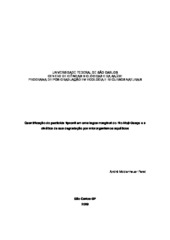Quantificação do pesticida fipronil em uma lagoa marginal do Rio Moji-Guaçu e a cinética de sua degradação por microrganismos aquáticos
Abstract
Óleo lagoon is a water body located at the border of the Jataí Ecological Station, next to extensive sugar-cane plantations that surround this conservation area. For this reason, there is a potential risk for contamination of this water body by pesticides that are widely used to protect the crops among them fipronil. This work aimed at characterize the Óleo Lake (an oxbow lake located at Moji-Guaçu river floodplain) under the optics of nutrient distribution, to access the concentrations of fipronil in the water body, as well as to develop a mathematical model able to predict the fate of fipronil when in contact to the water of the lake. Besides, it was carried out the isolation of microbial lineages from several compartments of the studied ecosystem. All these aspects were discussed based on a risk assessment diagram in the present work. Results show a great alloctonous organic matter contribution, especially on the rainy season, which shows that the application of pesticides in the surroundings of Jataí Ecological Station can be an object of great concern. The high number of isolated microorganisms lineages capable of using fipronil as carbon source demonstrates that the environment can modify this compound into other molecules. A low but measurable concentration of fipronil was detected in only one sediment sample, which indicates that the contamination of the studied water body had already happened. A microcosm experiment showed that, when in contact to water, about 30% of fipronil moves quickly to the sediment (17 days half-life time). The other fraction is slowly degraded in water (43 days half-life time). In the sediment, biodegradation was an efficient pathway to reduce fipronil concentration (7 days half-life time), without reducing the toxicity. Microorganism populations capable of using fipronil as carbon source has grown in the fipronil contaminated microcosms but their diversity was reduced as a function of time, what is believed to be a result of a selection of microorganisms that are most efficient in using fipronil molecules as a function of exposure time.
